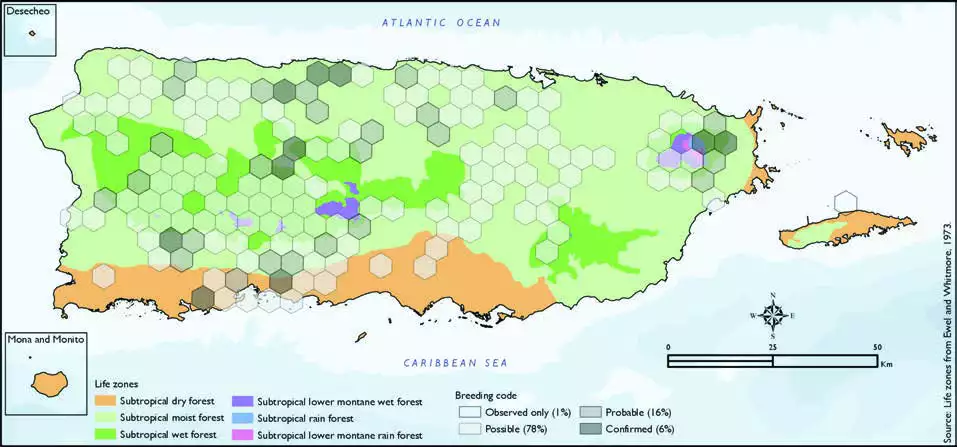Puerto Rican Lizard-Cuckoo
Description
The Puerto Rican lizard cuckoo (Coccyzus vieilloti) is a cuckoo endemic to the island of Puerto Rico, and is one of 4 species of lizard-cuckoos which occur only on Caribbean islands. These were formerly placed in the genus Saurothera (Greek for "lizard-eater") of the family Cuculidae, but are now lumped with Coccyzus (AOU 2006).
The Puerto Rican lizard cuckoo has a gray breast and chin, a tan lower body and brown upper body. It can be identified by its gray chin and breast and reddish-tan underbelly. The main identifying characteristic for this species is its long dark tail with two white spots on its outer tail feathers. It measures from 40 to 48 centimeters (16 to 19 inches) and weighs, on average, 80 grams (2.7 ounces).
Distribution & Habitat
The Puerto Rican Lizard-Cuckoo is endemic to Puerto Rico,
where it is fairly common at all
elevations (Raffaele and others
1998). It is considered a rare
visitor on Vieques (Gemmill
2015). This is a common species
in the haystack hills or mogotes
of the north coast, shade
coffee plantations, suburban
neighborhoods with dense
vegetation, and all mountainous
areas with thick forests, and
occurs in xeric forests in the
vicinity of Guánica (Oberle 2018,
Raffaele 1989a). Typical locations
to find this species are at the
Granados Trail in Guánica State
Forest, on the trails at Guajataca
and Vega State Forests, or around the parking lot and entrance
road to El Portal visitor center
in El Yunque National Forest
(Oberle 2018). It is also common
below 900 m in Los Tres
Picachos State Forest (Miranda-
Castro and others 2000). The
atlas fieldwork yielded a total of
269 records within 161 hexagons
or 34 percent of the 479 total
hexagons (see map). Of the 161
hexagons where this species
was found, breeding met the
atlas definition of confirmed in
6 percent (10) of the hexagons,
probable in 16 percent (25), and
possible in 78 percent (125),
while the species was observed
in 1 percent (1) of the hexagons
but without evidence of breeding
(see map). Puerto Rican Lizard-Cuckoo distribution. The map shows the highest breeding code by hexagon and overlaying the ecological life
zones in Puerto Rico. Note: percentages may not total 100 due to rounding. 73Puerto Rican Lizard-Cuckoo/Pájaro Bobo Mayor

Breeding Habits
Based on the limited data available, the Puerto Rican
Lizard-Cuckoo appears to breed
throughout the year (Raffaele
and others 1998). Pairs start
courtship early in the year when
males bring nesting materials to
the females (J.A. Salguero-Faría,
personal observation 2009). The
nest is a loose structure made
of leaves and sticks (Raffaele
and others 1998). Atlas results
show that this species breeds
throughout the year with the most breeding activity from
March to June (see chart).
Breeding activity peaks during
April, and it mostly takes place
within the subtropical moist
forest life zone (58 percent of
the hexagons) (see table). It also
breeds within the subtropical
wet and subtropical rain forest
life zones (32 and 1 percent of
the hexagons, respectively), as
well as in the southern coastal
plain within the subtropical dry
forest life zone (9 percent of the
hexagons) (see table and map).
Conservation
This species is currently listed as a species of least concern by
the IUCN (BirdLife International
2016). Locally, this species is not
listed in any of the threatened
categories of PRDNER and
USFWS. In Puerto Rico, the
Puerto Rican Lizard-Cuckoo has
a protected habitat in land of 17
percent or 651 km2 of the total area covered by the hexagons
where evidence of breeding
was found for this species
(3828 km2).
Related Species
Family:
cuckoo